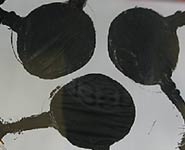The study, by Dr Jonathan Rossiter, Senior Lecturer in the Department of Engineering Mathematics and Dr Andrew Conn, Lecturer in the Department of Mechanical Engineering, is published today [2 May] in IOP Publishing’s journal Bioinspiration and Biomimetics, and is accompanied by a video (www.youtube.com/watch?v=W2CgtJU3ckY) showing the camouflaging in action.
“We have taken inspiration from nature's designs and exploited the same methods to turn our artificial muscles into striking visual effects,” said lead author of the study Dr Jonathan Rossiter.
The soft, stretchy, artificial muscles are based on specialist cells called chromatophores that are found in amphibians, fish, reptiles and cephalopods, and contain pigments of colours that are responsible for the animals’ remarkable colour-changing effects.
The colour changes in these organisms can be triggered by changes in mood, temperature, stress or something visible in the environment, and can be used for camouflage, communication or attracting a mate.
Two types of artificial chromatophores were created in the study: the first based on a mechanism adopted by a squid and the second based on a rather different mechanism adopted by zebrafish.
A typical colour-changing cell in a squid has a central sac containing granules of pigment. The sac is surrounded by a series of muscles and when the cell is ready to change colour, the brain sends a signal to the muscles and they contract. The contracting muscles make the central sacs expand, generating the optical effect which makes the squid look like it is changing colour.
The fast expansion of these muscles was mimicked using dielectric elastomers (DEs) – smart materials, usually made of a polymer, which are connected to an electric circuit and expand when a voltage is applied. They return to their original shape when they are short circuited.
In contrast, the cells in the zebrafish contain a small reservoir of black pigmented fluid that, when activated, travels to the skin surface and spreads out, much like the spilling of black ink. The natural dark spots on the surface of the zebrafish therefore appear to get bigger and the desired optical effect is achieved. The changes are usually driven by hormones.
The zebrafish cells were mimicked using two glass microscope slides sandwiching a silicone layer. Two pumps, made from flexible DEs, were positioned on both sides of the slide and were connected to the central system with silicone tubes; one pumping opaque white spirit, the other a mixture of black ink and water.
“Our artificial chromatophores are both scalable and adaptable and can be made into an artificial compliant skin which can stretch and deform, yet still operate effectively. This means they can be used in many environments where conventional 'hard' technologies would be dangerous, for example at the physical interface with humans, such as smart clothing,” continued Rossiter.
Paper: Biomimetic chromatophores for camouflage and soft active surfaces, Jonathan Rossiter, Bryan Yap and Andrew Conn, Bioinspiration & Biomimetics, published online 2 May 2012.

